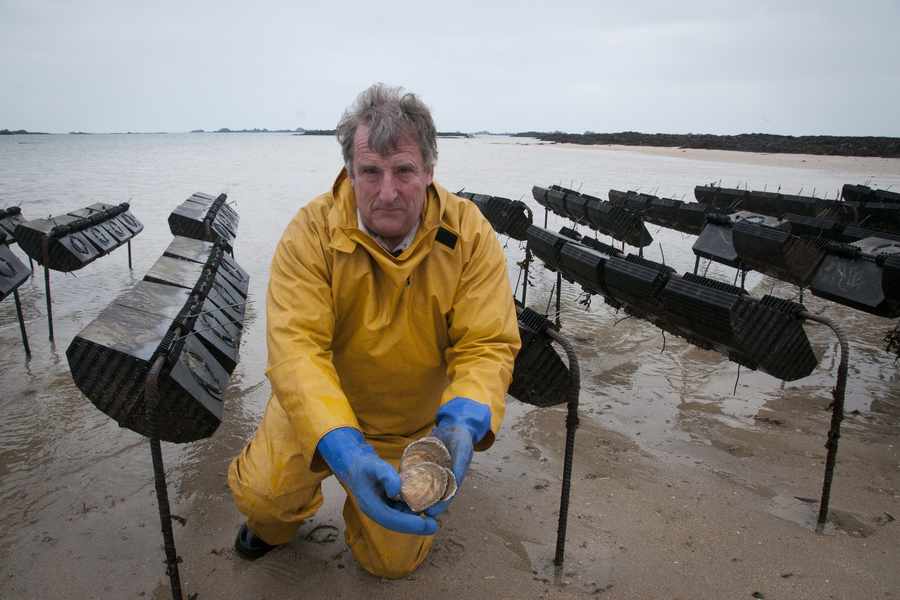
- Research shows that 9.5g of nitrogen can be removed from water a year by one kilo of oysters
- An estimated 2,000 tonnes of oysters are produced each year, with 70 per cent harvested
- Existing aquaculture sites would allow production to increase to 5,000 tonnes a year
- The main species of oyster in Jersey is the native Ostrea edulis
- Jersey Sea Farms bought four million seed oysters in 2013 and 2014, but need 75 million for the project[/breakout]
Tony Legg, who is developing a micro-reef system for cultivating oysters, believes that Jersey could expand its production to have an industry similar in size to the Jersey Royal potato, while also tackling the unsightly annual problem of sea lettuce blighting the bay.
He is hoping to run a test scheme to lay a series of micro-reefs – specially designed racks that would sit in cages on the sea-bed – at an existing scallop farm near Belcroute, which would remain underwater and out of sight.
According to Mr Legg, who runs Jersey Sea Farms, the oysters could reduce the risk of sea lettuce blooms by feeding on phytoplankton and food debris in the bay, reducing the nutrition available to the weed.
As part of the scheme, he is hoping to get permission to turn disused Fire and Rescue Service reservoirs at La Collette into ‘spatting ponds’, which are used to house seed oysters before they mature and can be transferred to coastal locations to grow.
Under the plans, oysters could be transferred from these ponds to existing nurseries on the south-east coast before being placed in Mr Legg’s specially designed micro-reefs in St Aubin’s Bay. He has asked the States for permission to use the reservoirs.

The project has received the backing of environmental campaigners Save Our Shoreline Jersey, who have today voiced their support through a letter to the JEP. (see below)
‘The oyster ecosystem service could work especially well when combined with a reduction in surface water run-off nitrates from agriculture and the States-planned improvement in the sewage treatment works.
‘The latter may also improve the water quality from a bacterial point of view, making it easier to purify the oysters for sale. It is entirely feasible to produce an oyster industry the size of the Jersey Royal potato business.’
From Dave Cabeldu, co-ordinator, SOS Jersey.

SOS Jersey first proposed the idea of reintroducing the Jersey native oyster (ostrea edulis) into St Aubin’s Bay a year ago.
We had discussed it briefly with two ministers who seemed verykeen, so we were surprised to hear that the new Council of Ministers had met and decided that there is no solution to the sea lettuce problem. We disagree.
We have researched the subject further and we believe that a solution could be less than three years away if a trial is undertaken now without further delay. There are no downsides or great costs involved, and it would be an innovative and exciting ‘Jersey project’.
Studies we have seen show that the circulation of the waters in St Aubin’s Bay on most tides is just that – circular. Drogues released at the end of the Bellozanne outflow either ‘returned to base’, or went east into St Clement’s Bay, so extending the outflow would not be the answer as often suggested. It would also be hugely expensive.
UK consultants last year went out looking for the ‘mother lode’ believing that it was possible that the lettuce was coming from elsewhere. This is not so. The ulva cells are present in the water column constantly. As one sees in our reservoirs when an algae bloom occurs, the same principle applies to St Aubin’s Bay; a combination of slack tides, hot weather and high nitrates in the water will suddenly trigger the growth of the ulva which is not washed away due to the circulation of the bay in normal summer conditions. Therefore reducing the nitrate load in the bay by a relatively small amount should elevate the ‘trigger point’ that sets off the process.
By growing juvenile Jersey native oysters below low-water level in self-contained ‘micro reefs’, the nitrate load could reduce by 25% by year three. The ‘native’ has a unique biology. It not only takes up a lot of nitrates in its bulk, but also excretes biological products that are broken down in the sand by micro-organisms and turned into nitrogen gas which bubbles to the surface. It is estimated that just 125 tonnes of juvenile oysters would extract 35-40 tonnes of nitrates, or over 25%.
The oysters will be invisible below the low water line and can be commercially harvested so would be of economic benefit to the Island. If necessary they can be filtered in existing tanks before sale as the pacific oysters sometimes have to be, so there is no bacterial issue.






